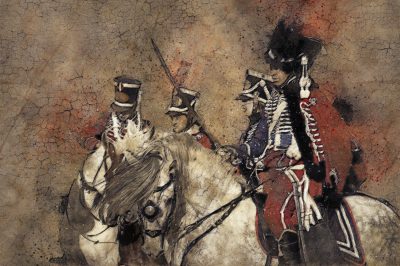
Throughout history, disease is one of the largest drivers of the development of both the veterinary profession and standardized veterinary education. The first veterinary school was created, in part, because of a rinderpest epidemic in France, but there always has been another driver of veterinary medicine: war.
Animals have long been part of war efforts (see the Roman Empire), and where you have animals, you’re going to need veterinarians. During the colonial period in the United States, the population was not large or densely concentrated, which helped keep it mostly free of dangerous epizootics (disease events in a nonhuman animal population), such as rinderpest. Without widespread disease affecting livestock, there didn’t seem to be a need for veterinarians or formalized veterinary education.
In the early 1800s, veterinarians formally educated in Europe began coming to the States, but they were few and far between. For the next century in the United States, most practitioners were not formally educated. Instead, education was gained from hands-on experience or through work with others who had experience, and that experience was largely specialized. For example, a gelder wouldn’t vary too far outside that job description. Farriers dealt with horses and cow leeches dealt with cows and other livestock.
But, for the most part, the care of animals was left to their owners.
War and Epizootics
The Revolutionary War also coincided with the first major epizootics on record in the States. A decade after the War ended, Texas fever, which was largely considered a disease of the south, made it as far north as Maryland and Pennsylvania. In 1795, the North Carolina State Legislature passed an act to prevent the driving of cattle from timber (read: tick) country into or through the state. This was the first legislative act ever passed in connection with animal diseases in the United States.
The Revolutionary War
Instead of the recognition of the importance of veterinarians coming into the US through the need to fight disease, it first became apparent through war. The Revolutionary War marks a time when the conversation around veterinary medicine began to change.
In 1776, George Washington issued an order that each newly formed regiment include a farrier knowledgeable in horse care, who would be responsible for the cavalry horses. These farriers were the first “veterinarians” in the US Army. While these farriers still had no formal education, this was at least a step in the right direction.
The Civil War
In the decade prior to the Civil War, there were dozens of attempts to start veterinary schools in North America, but most of them quickly failed, including efforts to start a formal Army Veterinary Corps and create a school for instructing Army veterinarians. When the Civil War started in 1861, only one veterinarian who served in the US military had ever held a post-secondary degree in Veterinary Science. In fact, there were only about 50 formally trained veterinarians in the whole country, and they had all studied abroad. This meant most military veterinary staff in the US were untrained.
The Union and Confederate armies took two separate views of horse care during the Civil War. The Union Army recognized the need for a formal veterinary service, but there were no set qualifications for those who joined. In fact, because recommendations made by veterinarians often involved taking horses out of commission, veterinarians were often ignored, to the detriment of both the animals and the war effort.
The Confederate Army similarly lacked both educated veterinarians and an understanding for why educated veterinarians were needed. They didn’t create a formal veterinary service; rather, they relied on each soldier to care for their own horse.
It wasn’t until 1879 that Congress passed a resolution that required all applicants for military veterinary positions to be graduates of a recognized veterinary college. In the late 1800s, nearly 30 veterinary schools were established across the country, including here at Michigan State University.
The World Wars
To prepare for the United States’ entry into World War I, President Woodrow Wilson—in conjunction with Congress—passed the National Defense Act of 1916. This Act included the creation of a Veterinary Corps within the US Army. They began with just 57 veterinarians, who worked—as we have seen throughout history—mostly on horses. However, the World Wars saw the expansion of veterinary medicine into areas that we recognize today as aspects of One Health. This began with the development of tests to detect botulism in canned foods.
Today, the Army Veterinary Corps includes nearly 900 men and women, and is supported by the larger Army Veterinary Service, which has been a part of every US conflict since World War I. It includes 1,600 food inspection specialists, 560 animal care technicians, and more than 400 civilian employees. These nearly 3,500 people support missions at home and abroad in areas including food safety, animal health care, public health, and research and development.
There are now 30 accredited schools or colleges of veterinary medicine in the United States, and approximately 3,000 students graduate from these schools each year.
